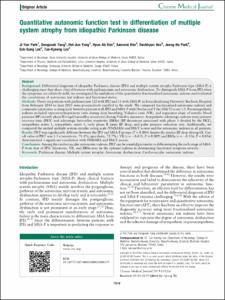Quantitative Autonomic Function Test in Differentiation of Multiple System Atrophy From Idiopathic Parkinson Disease
- Keimyung Author(s)
- Kim, Hyun Ah
- Department
- Dept. of Neurology (신경과학)
- Journal Title
- Chinese medical journal
- Issued Date
- 2019
- Volume
- 132
- Issue
- 16
- Keyword
- Parkinson disease; Multiple system atrophy; Autonomic dysfunction; Cardiovascular autonomic indexes
- Abstract
- Background:
Differential diagnosis of idiopathic Parkinson disease (IPD) and multiple system atrophy-Parkinson type (MSA-P) is challenging since they share clinical features with parkinsonism and autonomic dysfunction. To distinguish MSA-P from IPD when the symptoms are relatively mild, we investigated the usefulness of the quantitative fractionalized autonomic indexes and evaluated the correlations of autonomic test indexes and functional status.
Methods:
Thirty-six patients with parkinsonism (22 with IPD and 14 with MSA-P) in Soonchunhyang University Bucheon Hospital from February 2014 to June 2015 were prospectively enrolled in the study. We compared fractionalized autonomic indexes and composite autonomic scoring scale between patients with IPD and MSA-P with Hoehn and Yahr (H&Y) score 3. Parasympathetic indexes included expiratory/inspiratory ratio during deep breathing, Valsalva ratio (VR), and regression slope of systolic blood pressure (BP) in early phase II (vagal baroreflex sensitivity) during Valsalva maneuver. Sympathetic adrenergic indexes were pressure recovery time (PRT) and adrenergic baroreflex sensitivity (BRSa) (BP decrement associated with phase 3 divided by the PRT), sympathetic index 1, sympathetic index 3, early phase II mean BP drop, and pulse pressure reduction rate. Additionally, we compared the unified multiple system atrophy rating scale (UMSARS) and H&Y scores and the autonomic indexes in all patients.
Results:
PRT was significantly different between the IPD and MSA-P groups (P = 0.004) despite the similar BP drop during tilt. Cutoff value of PRT was 5.5 s (sensitivity, 71.4%; specificity, 72.7%). VR (r = 0.455, P = 0.009) and BRSa (r = 0.356, P = 0.036) demonstrated a significant correlation with UMSARS and H&Y scores.
Conclusions:
Among the cardiovascular autonomic indexes, PRT can be a useful parameter in differentiating the early stage of MSAP from that of IPD. Moreover, VR, and BRSa may be the optimal indexes in determining functional symptom severity.
- Keimyung Author(s)(Kor)
- 김현아
- Publisher
- School of Medicine (의과대학)
- Citation
- Ji-Yun Park et al. (2019). Quantitative Autonomic Function Test in Differentiation of Multiple System Atrophy From Idiopathic Parkinson Disease. Chinese medical journal, 132(16), 1919–1924. doi: 10.1097/CM9.0000000000000359
- Type
- Article
- ISSN
- 2542-5641
- Source
- https://insights.ovid.com/crossref?an=00029330-201908200-00005
- Appears in Collections:
- 1. School of Medicine (의과대학) > Dept. of Neurology (신경과학)
- 파일 목록
-
-
Download
 oak-2019-0305.pdf
기타 데이터 / 496.2 kB / Adobe PDF
oak-2019-0305.pdf
기타 데이터 / 496.2 kB / Adobe PDF
-
Items in Repository are protected by copyright, with all rights reserved, unless otherwise indicated.